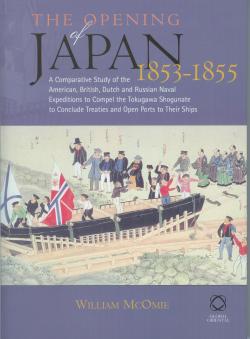The Opening of Japan 1853-1855: A Study of the American, British, Dutch and Russian Naval Expedition

The Opening of Japan 1853-1855: A Comprehensive Study of the American, British, Dutch and Russian Naval Expeditions to Compel the Tokugawa Shogunate to Conclude Treaties and Open Ports to Their Ships
By William McOmie
Global Oriental, Folkestone, 2006
ISBN 1-901903-76-1
Review by Sir Hugh Cortazzi
The assertion that Commodore Perry of the US Navy and his 'Black Ships' opened Japan in the middle of the nineteenth century is widely accepted as the historical truth but 'belongs more to the realm of historical myth'(p.xi). Professor McOmie notes that although 'Perry was the first to actually sign a treaty with the Japanese government' 'What Perry did was not so much to open the door, as to unlock the door, and force in a thin wedge to prevent it being bolted again'(page 462). The author reminds us that Japan was never quite as 'closed' as popularly believed and that the 'opening' of Japan continues to this day. The pressures for greater contacts with the outside world than that provided through the Dutch outpost at Deshima in Nagasaki bay had been building up for decades, not least from the Russians and could not be resisted from much longer. Perry just got there first and McOmie's detailed narrative outlines the roles played not only by the Americans but also by British and Dutch and more significantly by the Russians.
Professor McOmie's book, which is meticulously researched, provides a full account of the various expeditions to Japan and of the different sets of negotiations which resulted in the first treaties signed with Japan by the United States, Britain, Russia and the Netherlands in 1854/55. The Japanese did all they could to delay concessions and to play on the mutual suspicions between the foreign powers. As a result the four treaties concluded contained significant differences. In Chapter 13 the author provides an interesting analysis and comparison of the four treaties. None of them were true commercial treaties although the Dutch Treaty of January 1856 was called a Treaty of Commerce. The Treaties which were essentially arrangements for shipping needing to take on supplies in Japan, however, provided the basis on which the 'unequal' Treaties of 1858 were built. These later treaties opened Japanese ports to trade from 1859 and established the system of extraterritoriality which only ended in 1899 when revised treaties came into force.
Inevitably Professor McOmie devotes a major part of his book to an account of the US expeditions of 1853 and 1854. He has drawn on a large number of sources and gives a graphic picture of the events and personalities involved. He does not gloss over Commodore Perry's arrogance, his prejudice against the Dutch and his suspicions of the 'duplicitous' Japanese. He notes that Perry in his determination to get a treaty may well have used threats which went beyond his instructions (page 242). Perry may have been right in his insistence on status and protocol when dealing with the officials of the Bakufu who were conservative and rigid, but it seems ultra-pompous if not farcical to us today. So too do the intricate arrangements made by the visitors and by the Japanese for exchanges of gifts where the value and nature of the gift had to be carefully graded to accord with the ranks of the recipients and of the givers.
McOmie in his account of the Japanese response to the foreign expeditions stresses the problems caused by interpretation between Japanese and Dutch and then into English. The vocabulary of the interpreters was 'archaic and lacking in political, economic and diplomatic terms' (page 330). This remained a problem in relations with Japan throughout the 1850s and was only gradually overcome in the 1860s as increasing numbers of Japanese took up the study of English and a few foreigners such as Ernest Satow managed to master Japanese.
His account of the British negotiations is largely based on the work done by Professor Beasley. Of greater interest and less well known is his summary of the Dutch negotiations and of the Dutch involvement with the other foreign powers, but the most interesting and significant part of this book is the author's detailed account of the Russian expeditions and negotiations with the Japanese. He also gives a valuable summary of earlier Russian contacts with Japan, going back to the late seventeenth century, drawing on his own work incorporated in his book Foreign Images of Japan Volume 1 First Century AD - 1841, Global Oriental, 2005. McOmie has made extensive use of Russian archives, which have not been published in English translations and have therefore not been easily available to American historians. He points out the more conciliatory attitude adopted by Admiral Putiatin, the Russian negotiator, in contrast to that of Commodore Perry, and he notes the friendly treatment accorded by the Japanese authorities after the Russian ship Diana foundered as a result of an earthquake and tidal wave at Shimoda in 1854. The Russians in Japan at this time faced particular difficulties because of the Crimean War. This meant that British and French ships sought to intercept them. McOmie gives a fascinating account not only of the way in which the Russian sailors with help from Japanese craftsmen built a schooner at Heda in the Izu peninsular as a partial replacement of the Diana but also of their attempts to charter a couple of foreign vessels which called at Shimoda to take members of the Diana's crew back to Russia. Some did get back but others were taken prisoner by British ships.
This book is essential reading for all students of the history of Japan's foreign relations and copies should be in all relevant libraries.

